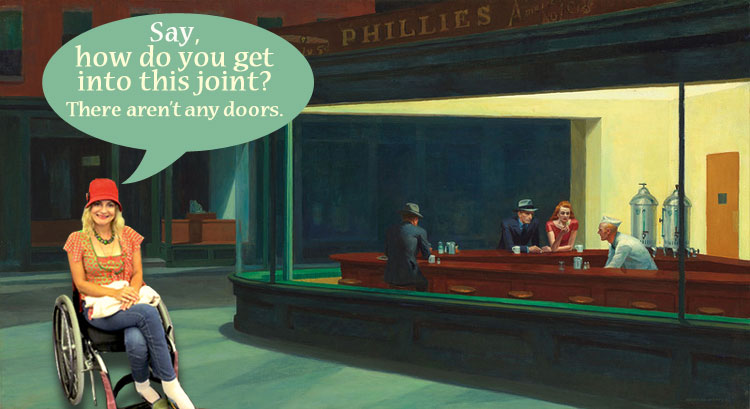 I was in college when I first fell in love with artist Edward Hopper’s paintings exhibited at The Neuberger – the State University of NY at Purchase art museum. I was mesmerized by “The Barber Shop.” The greens, blues and yellows were so bright and vivid that I was immediately drawn in. Whenever I felt stressed from intense Visual Arts classes, I would dash from my studio and sit on the floor in front of this painting and contemplate.
I was in college when I first fell in love with artist Edward Hopper’s paintings exhibited at The Neuberger – the State University of NY at Purchase art museum. I was mesmerized by “The Barber Shop.” The greens, blues and yellows were so bright and vivid that I was immediately drawn in. Whenever I felt stressed from intense Visual Arts classes, I would dash from my studio and sit on the floor in front of this painting and contemplate.
The Whitney Museum in NYC exhibited the works of Edward Hopper which ended October 6th. It was the first major museum exhibition to focus not only on his most famous paintings, but on the 200 drawings which he sketched to accompany them. One other note, The Whitney also owns more Hoppers than any other museum.
Hopper started his career as a draftsman and illustrator after studying at the NY School of Art. Disillusioned by his career in the commercial arts and being forced to draft sentimental pulp fiction, he chose the path of fine artist.
As with so many fine artists, he was intrigued by Paris and chose to spend a few years there. The Parisian cafe scene enthralled and inspired him. He also greatly admired famous French painters such as Degas and Toulouse Lautrec who depicted the Parisian cafe and night life that was so popular in the late 19th century.
Two of my favorite works in the exhibit’s “Paris” room are ‘Soir Bleu’ and ‘Couple Drinking.’
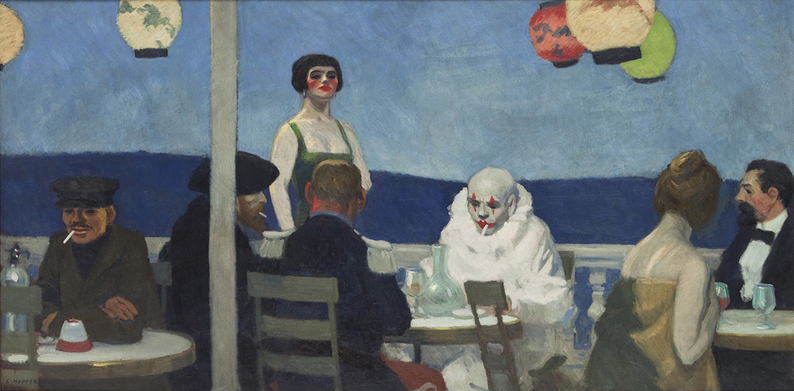
Soir Bleu, 1914. Oil on canvas, Overall: 36 × 72 in. (91.4 × 182.9 cm). Whitney Museum of American Art, New York; Josephine N. Hopper Bequest 70.1208. Photograph by Sheldan C. Collins. © Heirs of Josephine N. Hopper, licensed by the Whitney Museum of American Art. Digital image © Whitney Museum of American Art
I couldn’t help but chuckle when I saw the image of the smoking clown, the focal point of this work. I imagined him to be drunk, down and out, upset that he’s had to resort to clown entertainment for kids as his main source of income. His only solace to get through this torture was to make a mad dash to his favorite haunt, where he could pull out a smoke and polish off several glasses of absinthe.
My chuckle turned into a smile when I read on the plaque about the clown’s company. A true synthesis of societal types and class. The man on the left is a pimp and in French slang, “un maquereau” or mackerel, which also implies the woman to his right is a prostitute. The other characters are bourgeois men.
Unfortunately critics panned Soir Bleu, so Hopper wrapped up the painting and it was hidden until his death.
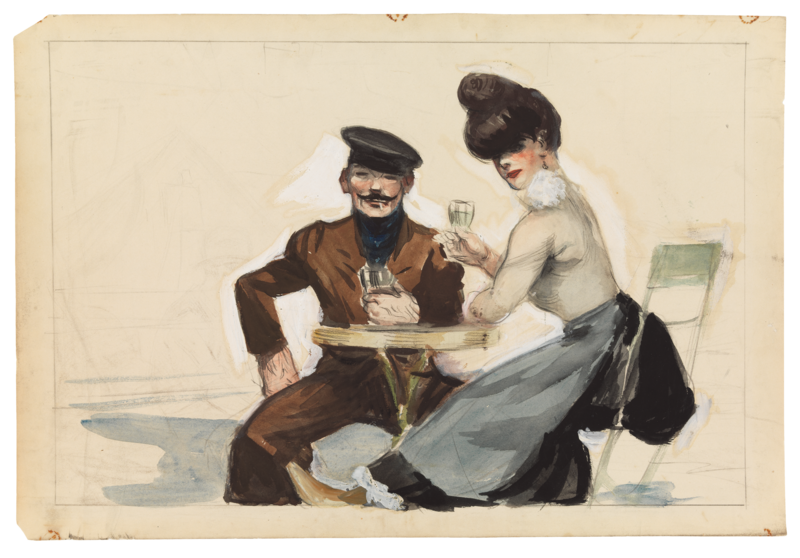
Couple Drinking, 1906–07. Transparent and opaque watercolor, graphite pencil, and fabricated chalk on paper, 13 1/2 × 19 7/8 in. (34.3 × 50.5 cm). Whitney Museum of American Art, New York; Josephine N. Hopper Bequest 70.1340. © Heirs of Josephine N. Hopper, licensed by the Whitney Museum of American Art. Digital image © Whitney Museum of American Art
Couple Drinking – 1906 – What a charming couple deftly sketched and so comfortable and carefree in their cafe surrounding. I picture this couple in modern day Brooklyn captured by the Sartorialist, a street style photographer. However, the modern day gal could be seen with unkempt hair piled so high it resembles bread that never stops leavening. While Brooklyn males have turned their facial hair into a Dali-esque art form, heads are topped off with either a beret, fedora or leather baseball hat and $500 leather sneakers shod their feet while downing a pumpkin flavored Pilsner.
“I spend many days usually before I find a subject that I like well enough to do, and spend a long time on the proportions of the canvas.” – Edward Hopper
The next room is where one of his most recognizable work is on display – Early Sunday Morning – 1930 which was painted in his Washington Square North, NYC studio. He also built the easel upon which the painting rests. Sitting in front of this dulcet iconographic image, you can feel the bright oranges emanating warmth, and remain so vibrant after all these decades. I was so excited that the museum permitted photography of this well-known painting.
Nighthawks -1942 – is his most famous work and was displayed among 19 studies. It is also one that has been so overused in movies, TV and music that it has become a cliché. Nevertheless, I can’t help but love this work. Hopper is a master when it comes to capturing light on a subject. Here you have 4 faceless figures together but apart, despondent, with a bright fluorescent light forcing them to stay awake because there is no entrance or exit to be found. Luckily, two coffee urns are there to keep them awake. Today, these four could easily be found at a Starbucks, emotionally detached, tweeting about whether Miley Cyrus will end up in rehab or inanely debating whose fault it is for the government shut down.
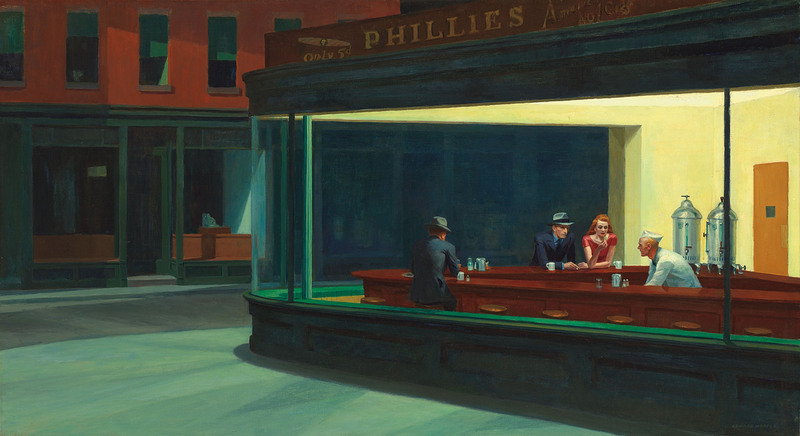
Nighthawks, 1942. Oil on canvas, 33 1/8 × 60 in. (84.1 × 152.4 cm). The Art Institute of Chicago; Friends of American Art Collection 1942.51. Photography © The Art Institute of Chicago
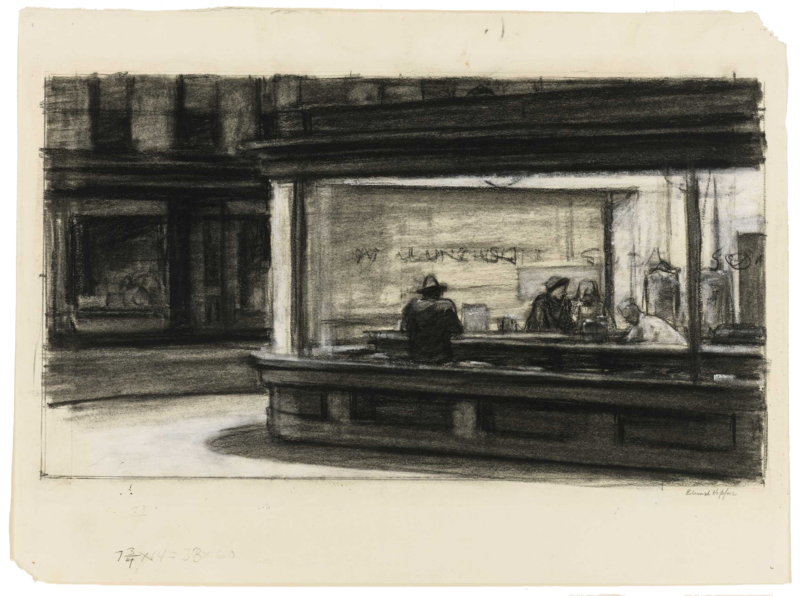
Study for Nighthawks, 1941 or 1942. Fabricated chalk and charcoal on paper; 11 1/8 × 15 in. (28.3 × 38.1 cm). Whitney Museum of American Art, New York; purchase and gift of Josephine N. Hopper by exchange 2011.65. © Heirs of Josephine N. Hopper, licensed by the Whitney Museum of American Art. Digital image © Whitney Museum of American Art
NY Movie – 1939 – Edward Hopper loved the cinema and sketched many movie houses over the years. For this painting he studied 4 theaters and completed 52 studies before completing this work. Why is the illuminated pensive usherette the focal point of this work? He could have spent more time on movie house architectural detail and only gives us a hint of the black and white film flickering on the left side. Curious to know which film he was watching. Could it have been ‘Ninotchka’ or even ‘Dark Victory’?
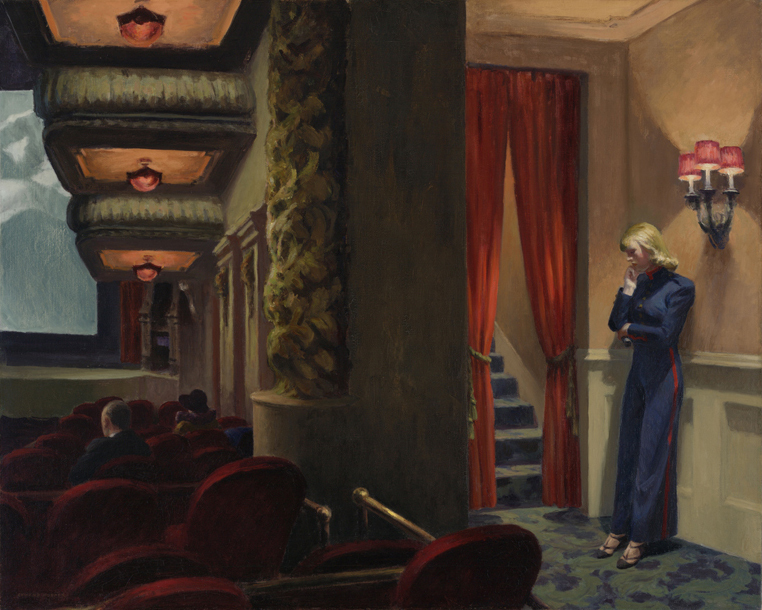
New York Movie, 1939. Oil on canvas, 32 1/4 × 40 1/8 in. (81.9 × 101.9 cm). The Museum of Modern Art, New York; given anonymously 396.1941. Digital Image © The Museum of Modern Art/Licensed by SCALA / Art Resource, NY
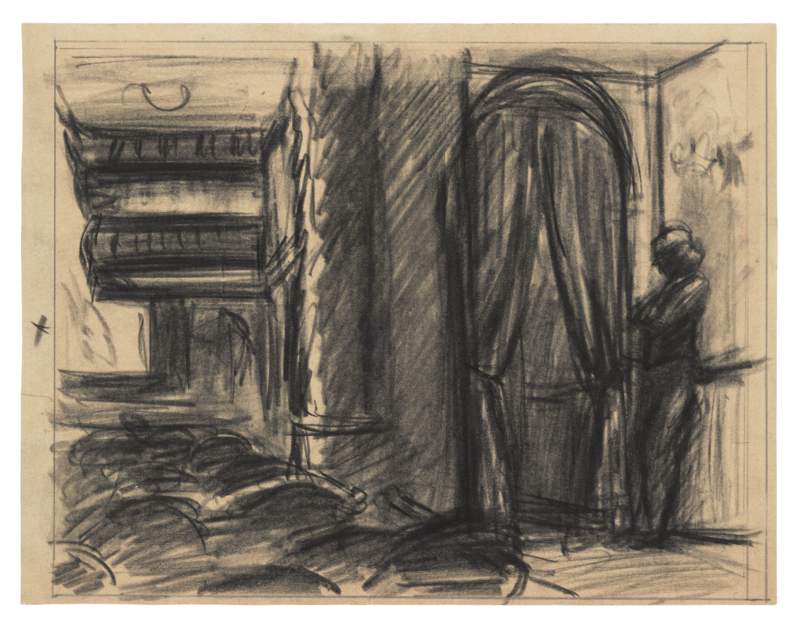
New York Movie, 1939. Oil on canvas, 32 1/4 × 40 1/8 in. (81.9 × 101.9 cm). The Museum of Modern Art, New York; given anonymously 396.1941. Digital Image © The Museum of Modern Art/Licensed by SCALA / Art Resource, NY
The final room of the exhibit displayed the works he painted while vacationing in New England with his wife Josephine, his primary subject in some of his works.
Gas – 1940 – I am not sure whether Hopper’s subject of a lone gas station in an idyllic landscape is symbolic of the inevitable destruction of nature by toxicity or he simply liked the look of the gas station. Perhaps he left NYC in order to paint bucolic settings, but his work still focuses on a solitary subject basking in bright light. If only today’s gas stations had the charm and simplicity of yesteryear as depicted by Hopper! Instead, today’s gas stations are a reminder of our dependence on a finite energy source, strategically placed in front of hideous box like structures which sell pre-paid cell phone cards, salty-yellow-finger-staining-boxed snacks, cold brews and E-cigarettes.
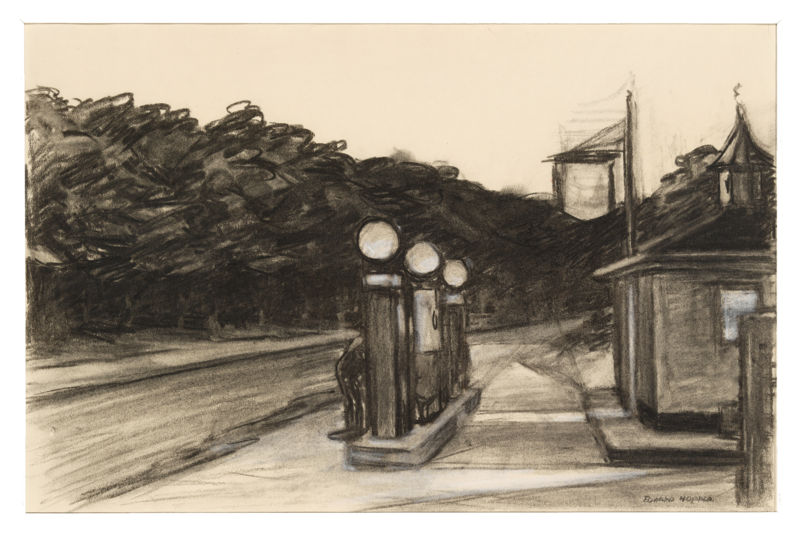
Study for Gas, 1940. Charcoal and white chalk with graphite pencil on paper, 15 1/16 × 22 1/8 in. (38.3 × 56.2 cm). Whitney Museum of American Art, New York; Josephine N. Hopper Bequest 70.349. © Heirs of Josephine N. Hopper, licensed by the Whitney Museum of American Art. Digital image © Whitney Museum of American Art
Carter Foster, curator of the drawings at the Whitney, did a wonderful job selecting pieces from more than 2500 drawings donated by Hopper’s widow. I had not known that Hopper meticulously completed so many studies for his famous works prior to this exhibit. Nor was I aware of the scope of his versatility as an incredible draftsman and painter who had the ability to capture the tranquility of solitude onto a canvas so convincingly.
My only disappointment was that his 1927 painting ‘Automat’ was not on display. I love the solitude of the cloche wearing woman and quiet surroundings as she is staring into her coffee cup. Is she lonely, sad, bored, or depressed? I feel comforted by this image since she is focused on only one thing. How different from today when multi-tasking is a way of life.
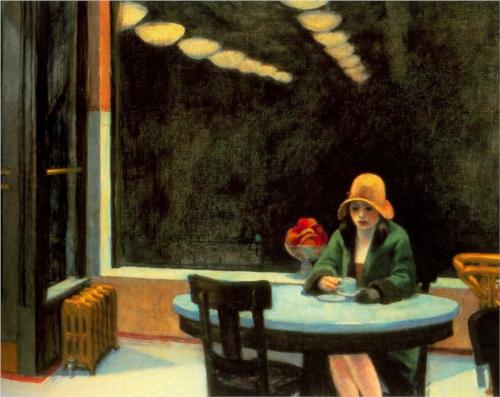 I had to recreate my own ‘Automat’ so I could envelope myself in the wafting scent of coffee without distractions. Ahhh, silence and stillness without the incessant ‘pinging’ of my phone.
I had to recreate my own ‘Automat’ so I could envelope myself in the wafting scent of coffee without distractions. Ahhh, silence and stillness without the incessant ‘pinging’ of my phone.
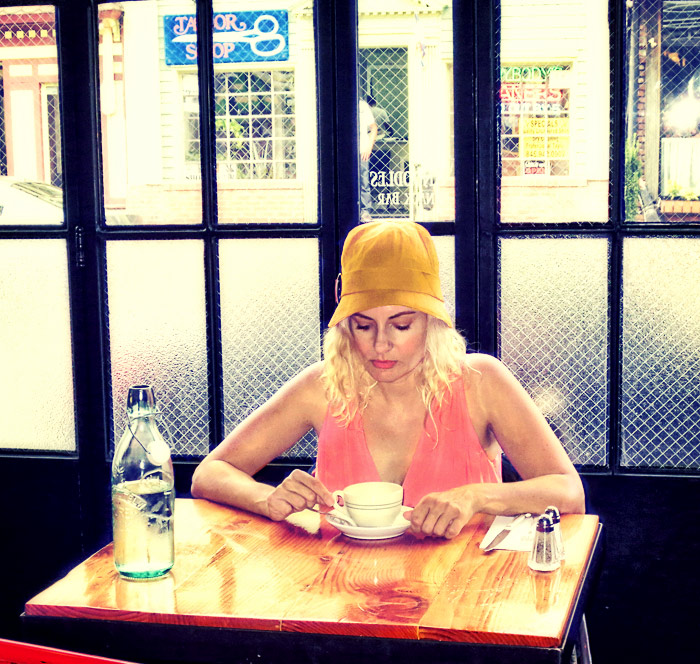 The Hopper show at The Whitney ends in October, then travels to the Dallas Museum of Art from November 17, 2013 to February 6, 2014 and the Walker Art Center from March 15 to June 22, 2014.
The Hopper show at The Whitney ends in October, then travels to the Dallas Museum of Art from November 17, 2013 to February 6, 2014 and the Walker Art Center from March 15 to June 22, 2014.
You can learn more about Hopper at the Edward Hopper House in Nyack, NY, his birthplace, childhood home and a Landmark Preservation Foundation. You can glimpse at memorabilia such as letters, documents and view photographs of places where the artist painted. The Hopper House is a special place because it was saved from disrepair by the local community after the artist’s death. This not-for-profit art center also exhibits works by local artists.
I have to close out this post with an image of the shoe(s) I wore to the exhibit. Do you think Edward would have approved? It doesn’t get brighter than these beauties. They received more attention than ‘Nighthawks’. You can find these darlings designed by an Icelandic duo’s brand named Kron.
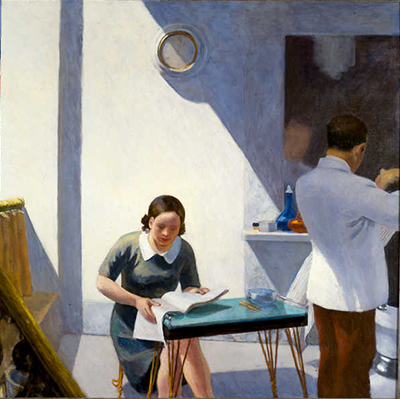
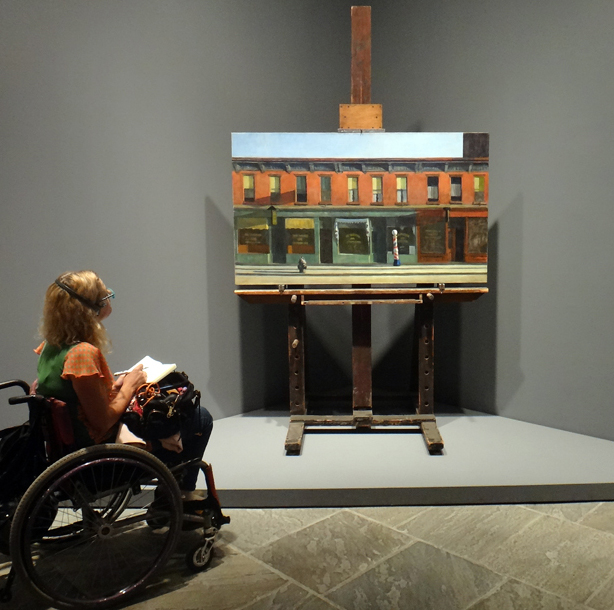
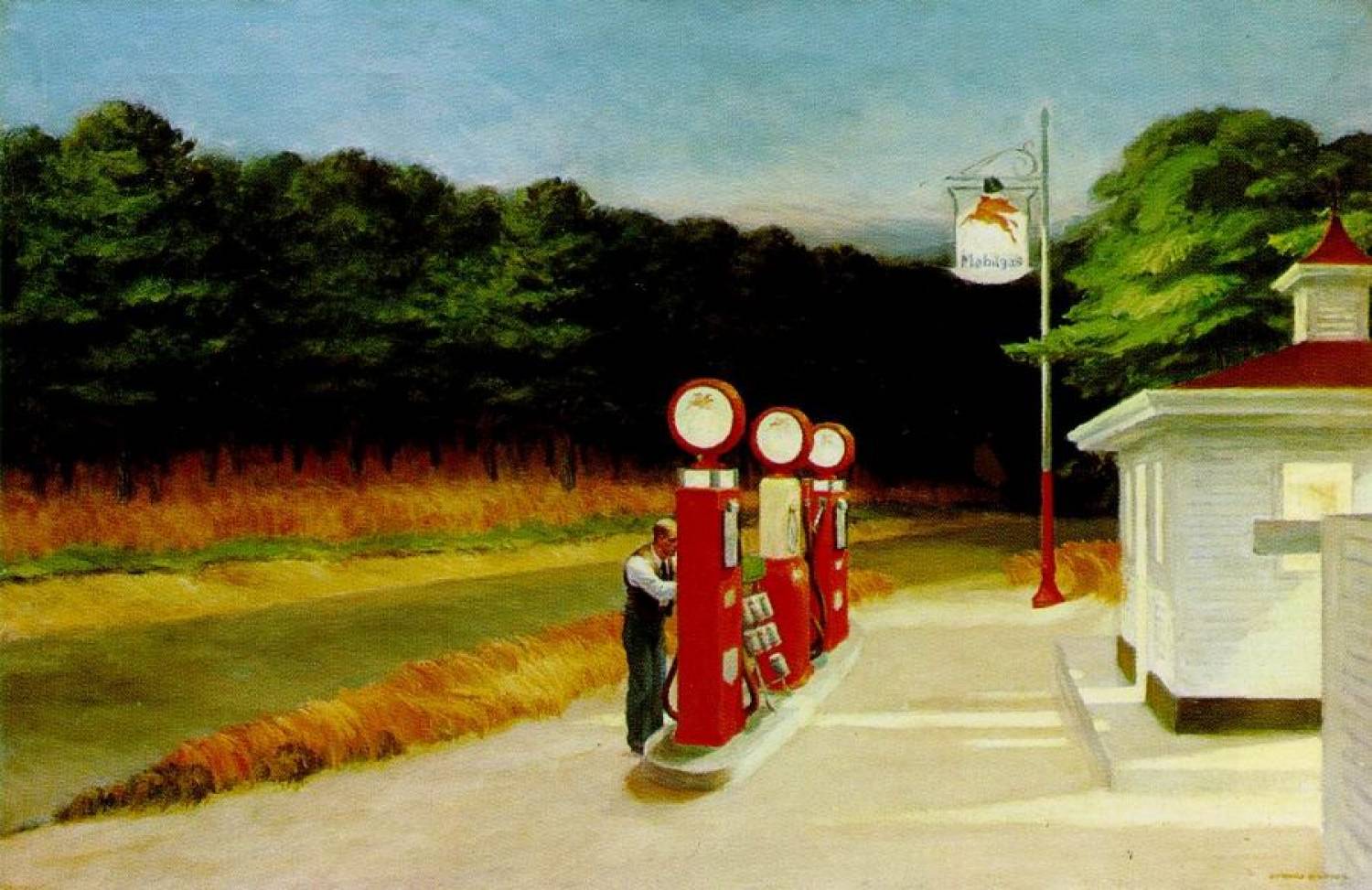
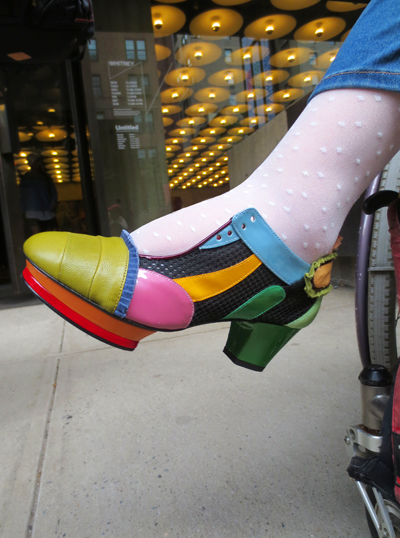






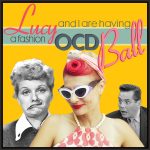





December 10, 2015 at 5:14 pm
Regards for this post, I am a big fan of thios
website would like to go along updated.
December 10, 2015 at 5:38 pm
HI, you can subscribe to receive updates on the website, top right corner. Just enter you email and hit “subscribe.” Thanks for reading my blog.
July 2, 2014 at 10:07 pm
The same happened to me! I was looking at some pictures on Google and saw yours, then visited your blog and loved it!
I send you a big hug from Argentina! (oh, we get very affectionate here!)
:)
Loló
July 14, 2014 at 11:10 pm
Thanks for commenting. I know Argentinians are affectionate. I send you big hugs back. Cheers.
May 20, 2014 at 8:34 am
I was pulled in from google images where I found you asking for the entrance to Nighthawks. Ingenious, simply ingenious :)
May 20, 2014 at 11:49 am
Thanks for visiting my blog and leaving a comment. Did you get to see Nighthawks or the show? It was superb.
October 10, 2013 at 5:26 am
What a great job you did! I am continually surprised that you find so many images from shows besides the pics we took (yeah, I’m proud of mine. lol). Also, LOVE LOVE LOVE you reenacting “Automat!” What a terrific idea. Re: the missing door in “Nighthawks?” It’s obvious they, (and we, the viewers?) are trapped in a timeless moment as rich in poignancy, and as rife for interpretation, perhaps, as the Mona Lisa, and one from which, there is no escape. It’s ironic/funny that the 3-D installation of “Nighthawks” in the prow of the Flatiron Building (a BRILLIANT idea), stayed true to this “no way out” you wonder about, and I found myself looking around for a door (since it was suggested to be one of the original inspirations for “Nighthawks” location. And yes, those shoes! I think Vincent would have been more into them!